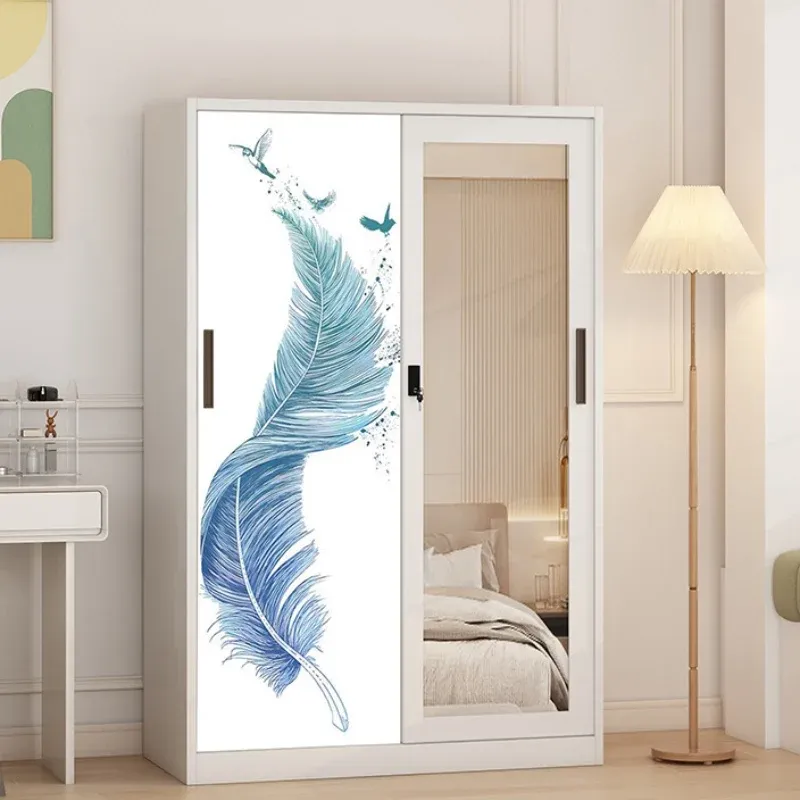Overview of Metal Wardrobes
Metal wardrobes, typically constructed from stainless steel, powder-coated aluminum, or galvanized steel, are known for their robustness and modern aesthetic. They often feature sleek designs with sliding doors, drawers, or shelves, making them ideal for contemporary bedrooms or high-use environments.
Overview of Wooden Wardrobes
Wooden wardrobes, made from solid woods like oak, pine, or engineered options like MDF, offer a classic and versatile look. Available in various finishes, from natural stains to painted surfaces, they suit a range of decor styles, from rustic to minimalist.
Durability Comparison: Metal vs. Wooden Wardrobes
Longevity depends on material quality, construction, and environmental factors. Below is an analysis of how metal and wooden wardrobes compare in terms of durability:
- Metal Wardrobes: High-quality metals like stainless steel resist rust, dents, and corrosion, often lasting 15-30 years with minimal maintenance. They withstand humid or high-traffic environments but may dent if made from thinner materials.
- Wooden Wardrobes: Solid wood wardrobes, when properly sealed, can last 20-50 years, but they are prone to warping or swelling in humid conditions. Engineered woods like MDF may degrade faster (10-20 years) if not treated.
Did You Know? Metal wardrobes can maintain structural integrity up to 90% longer than untreated wood in humid climates, making them a top choice for coastal or tropical regions.
Pros and Cons of Metal Wardrobes
Metal wardrobes offer distinct advantages for durability but have some limitations.
Pros
- High Durability: Resistant to rust, corrosion, and wear, especially with stainless steel or powder-coated finishes.
- Moisture Resistance: Ideal for humid or damp environments, preventing mold and mildew.
- Low Maintenance: Easy to clean with a damp cloth, requiring no sealing or refinishing.
- Modern Aesthetic: Sleek finishes like brushed steel suit contemporary or industrial bedrooms.
- Hygienic: Non-porous surfaces resist bacterial growth, enhancing cleanliness.
Cons
- Cold Appearance: Metal can feel stark or less cozy compared to wood’s warmth.
- Limited Customization: Fewer options for staining or reshaping compared to wood.
- Noise Potential: Metal doors or drawers may produce clanging sounds during use.
- Dent Risk: Thin or low-quality metal may dent under heavy impact.
Pros and Cons of Wooden Wardrobes
Wooden wardrobes provide timeless appeal but require more care to ensure longevity.
Pros
- Aesthetic Warmth: Adds a cozy, natural feel, complementing traditional, rustic, or Scandinavian decor.
- Customization Options: Easily painted, stained, or carved to match bedroom aesthetics.
- Longevity Potential: High-quality solid wood can last decades with proper care.
- Sound Insulation: Wood absorbs sound better, reducing noise from doors or drawers.
Cons
- Moisture Sensitivity: Prone to warping, swelling, or cracking in humid conditions unless sealed.
- Higher Maintenance: Requires regular sealing, refinishing, or polishing to maintain appearance.
- Weight: Solid wood is heavy, complicating installation or relocation.
- Cost Variability: Premium solid wood is expensive, while MDF may degrade faster.
Comparison of Metal and Wooden Wardrobes
The following table summarizes key differences, focusing on longevity and related factors:
| Aspect | Metal Wardrobes | Wooden Wardrobes |
|---|---|---|
| Durability | 15-30 years; rust-resistant | 10-50 years; depends on wood quality |
| Moisture Resistance | High; ideal for humid areas | Moderate; requires sealing |
| Maintenance | Low; wipe clean | High; sealing, refinishing needed |
| Aesthetic | Modern, industrial | Warm, traditional |
| Cost | $100-$500 | $150-$1000 |
| Best For | Humid, high-use environments | Classic, dry interiors |
When to Choose Metal Wardrobes
Metal wardrobes are the better choice for longevity in the following scenarios:
- Humid Climates: Ideal for coastal or tropical areas where moisture resistance is critical.
- High-Traffic Bedrooms: Durable for frequent use, especially in shared or family spaces.
- Modern Decor: Complements minimalist or industrial-style bedrooms.
- Low Maintenance Needs: Perfect for those seeking minimal upkeep.
When to Choose Wooden Wardrobes
Wooden wardrobes are preferable for longevity under these conditions:
- Dry Environments: Best in climate-controlled bedrooms with low humidity.
- Classic or Cozy Decor: Enhances traditional, rustic, or warm bedroom aesthetics.
- Customization Needs: Ideal for those wanting specific stains or designs to match existing furniture.
- Long-Term Investment: High-quality solid wood offers decades of use with proper care.
Common Questions About Wardrobe Durability
Below are answers to frequently asked questions to guide your decision:
- Which material lasts longer overall? Metal typically outlasts wood in humid or high-use conditions, but high-quality solid wood can last longer in dry, well-maintained environments.
- How do I protect wooden wardrobes? Apply sealant every 1-2 years and avoid placing in damp areas.
- Can metal wardrobes dent easily? High-quality stainless steel resists dents, but thinner metals may be prone to damage.
- Are wooden wardrobes worth the cost? Solid wood is a worthwhile investment for longevity, but MDF is less durable and more affordable.
- How do I prevent odors in wardrobes? Use ventilated designs or cedar inserts for both materials to maintain freshness.
Tips for Maintaining Wardrobes for Longevity
Proper maintenance extends the lifespan of both metal and wooden wardrobes:
- Clean Regularly: Wipe metal with a damp cloth; use wood-safe cleaners for wooden surfaces.
- Protect from Moisture: For wood, apply sealant; for metal, ensure no prolonged water exposure.
- Avoid Overloading: Follow weight limits for shelves and drawers to prevent damage.
- Inspect Hardware: Tighten screws and hinges annually to maintain structural integrity.
- Promote Ventilation: Use perforated panels or periodically open doors to reduce odors.
Conclusion
Choosing between metal and wooden wardrobes in 2025 depends on your priorities for durability, maintenance, and aesthetics. Metal wardrobes generally offer greater longevity in humid or high-use environments due to their rust resistance and low maintenance needs, lasting 15-30 years. Wooden wardrobes, particularly those made from solid wood, can last 20-50 years in dry conditions with proper care but require more upkeep. By considering your bedroom’s environment, decor style, and maintenance willingness, you can select a wardrobe that provides lasting storage and enhances your space’s functionality and appeal.
Table of Contents
- Overview of Metal Wardrobes
- Overview of Wooden Wardrobes
- Durability Comparison: Metal vs. Wooden Wardrobes
- Pros and Cons of Metal Wardrobes
- Pros and Cons of Wooden Wardrobes
- Comparison of Metal and Wooden Wardrobes
- When to Choose Metal Wardrobes
- When to Choose Wooden Wardrobes
- Common Questions About Wardrobe Durability
- Tips for Maintaining Wardrobes for Longevity
- Conclusion

